
Product test
NZXT H1: a monster case at a (seemingly) dizzying price
by Kevin Hofer

The first version of NZXT’s mini-ITX case already convinced me. And now, the H1 has only got better.
NZXT revolutionised the mini-ITX case market – small form factor PCs – two years ago with the H1. While such small cases were rather niche back then, they’re currently in fashion. Naturally, NZXT decided to revise the H1.
Slightly larger for more powerful graphics cards, increased power thanks to a larger voltage supply, an additional case fan and a PCIe 4.0 riser cable: the second H1 features few innovations, but they pack a punch. Its new riser cable might be the most interesting for knowledgeable readers. After all, it did carry a risk of short-circuiting in the original H1. This seems to be fixed now – my test sample didn’t catch fire after two weeks of use, at least.
Since I’ve already looked at the original H1 in detail, I’ll limit myself to the essentials in this review. If you want to know how it feels to work with the H1, check out my original article below.
In short: NZXT delivers a great building experience in both versions of the H1. Thanks to the labels, enough space and now even screws that don’t fall out when loosened, installing components is a breeze.
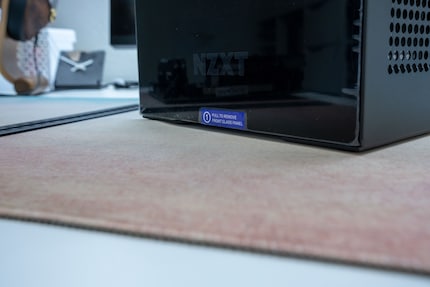
These days, the H1 is slightly larger, 19.6×19.6×40.5 (L×W×H) centimetres compared to 18.7×38.8×18.9 centimetres. Thanks to these new dimensions, the H1 can accommodate graphics cards up to 32.4 centimetres long and 5.8 centimetres thick. Among the top ports, there are now two instead of one USB 3.2 Gen. 1 Type A. The Type-C port in USB 3.2 Gen. 2 as well as the audio jack are also back in the updated version.
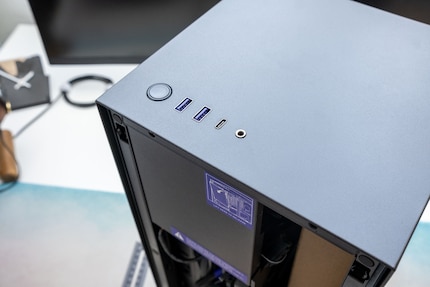
Inside, the power supply unit stands out. The second version offers 750 instead of 650 watts in the 80 Plus Gold standard. All cables are already routed accordingly, so you just have to plug them in.
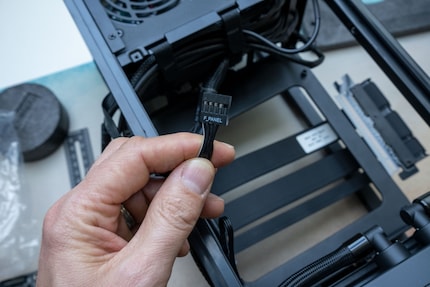
If you’re planning to install an Alder-Lake processor from Intel in the H1, NZXT also supplies the matching radiator mounting material for the integrated 140-millimetre all-in-one water cooling. Speaking of cooling: a 92-millimetre case fan is now mounted at the top rear. It’s supposed to move hot air out of the case more efficiently. A fan controller is now located in the flap for the drive cage. All components are already connected to it. You just have to plug the internal USB 2.0 cable into the mainboard. Thus, the entire cooling system can be controlled via the manufacturer’s CAM software.
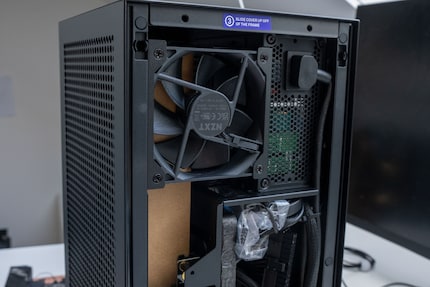
All the features of the H1 at a glance:
What still bothers me about the H1 is the tempered glass side panel. It doesn’t add any value for me. On the contrary, if it were made of perforated steel, temperatures within the H1 could be even lower. Like the side panel, the colours remain the same: the case is available in black or white.
To test for airflow, I subjected components installed in the case to stress tests AIDA64 – for the CPU – and FurMark – for the GPU. Both ran for 20 minutes. I measured CPU, GPU, SSD, motherboard and chipset temperatures with HWiNFO64. Fan control was set to default in the NZXT CAM software. By the way, you can also create your own profiles in the software. However, at time of testing, I could only control fan speeds and not that of the pump for the all-in-one water cooling system. After every two minutes, I noted the temperatures. Placing a sound level meter 30 centimetres in front of the case, I measured 38 dB at idle and 50 dB under load. The hum is low enough when idling to not be annoying. On the other hand, the fans are quite annoying at 50 dB. Check out temperature development for all components below (only in German):
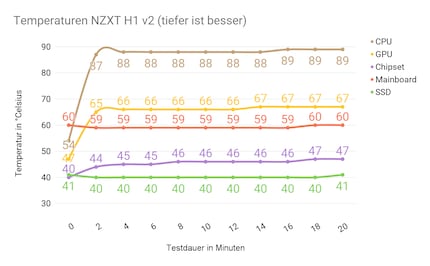
If I compare temperatures in the second version of the H1 with those of the first version, the CPU gets a maximum of 8 degrees Celsius hotter in the new version. This might be due to the installed graphics card. Since I’d installed a graphics card with a radial fan that blows hot air out the bottom of the case during my original test, less hot air from the GPU ended up in the case. The graphics card with its axial fan that I installed this time swirls hot air from the GPU through the case.
Since I couldn’t install my usual testing graphics card in the first version of the NZXT due to its thickness, I used a thinner one – one which happened to use a radial fan. However, this isn’t ideal in a vertical case such as the H1, since the graphics card gives off heat at the bottom of the case, building up heat there. Which is why I chose a different graphics card for my current review.
The graphics card remains a bit cooler in the second version of the H1. With a maximum of 67 degrees Celsius, it’s about as warm as Ssupd’s Meshlicious. A very good value. The H1’s temperatures are also similar to those of the Meshlicious. Only the CPU temperature is up to 13 degrees Celsius lower in the Meshlicious depending on its configuration. However, this is due to the all-in-one water cooling system it uses: at 240 millimetres, it offers considerably more radiator surface and therefore more cooling potential than the 140 in the H1.
Finally, the components used for this review:
With the second version of the H1, NZXT once again delivers a heavenly case. It impresses with its great workmanship and the unprecedented building experience. Regarding temperatures, the H1 can keep up with other mini-ITX cases like Ssupd’s Meshlicious, a great effort.
My only criticism of the case itself is the tempered glass side panel. Here I would’ve liked to see perforated steel, which would lead to even better temperatures. The H1 seems to be priced fairly, around 350 francs (as of: 22. March 2022) due to the components included. The Meshlicious with its PCIe 4.0 riser cable does cost over 100 francs less (as of: 22. March 2022), but neither the power supply nor the all-in-one water cooling system are included. The only comparably equipped case, the Master Box NR200P Max from Cooler Master, costs over 80 francs more (as of: 22. March 2022) than the H1.
For me, the H1 is a clear recommendation to buy for those who need a simple building experience and are looking for a small, compact case.
From big data to big brother, Cyborgs to Sci-Fi. All aspects of technology and society fascinate me.